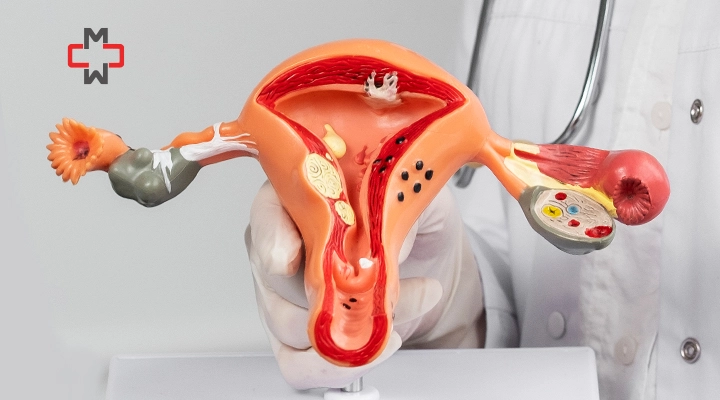Understanding Ovarian Cysts: When Should You Worry?
Ovarian cysts are fluid-filled sacs that form in or on the ovaries. Most of the time, they are harmless and go away on their own. However, some cysts can grow large, causing pain, discomfort, and serious health complications, such as ovarian torsion, rupture, and malignancy.
Ovarian cysts vary in size, and knowing when a cyst becomes dangerous is crucial for early detection and treatment.
What Size of Ovarian Cyst Is Dangerous in CM?
Medical experts suggest that cysts larger than 5 cm may require close monitoring, while those exceeding 10 cm are considered high-risk and may need surgical intervention.
🚨 Alarming Fact: A study published in the Journal of Obstetrics and Gynecology found that ovarian cysts over 10 cm have a higher risk of malignancy or complications. (Source: NCBI)
Ovarian Cyst Size: What You Need to Know
✅ Small cysts (under 5 cm): Usually harmless and resolve on their own.
✅ Medium cysts (5-10 cm): Need regular monitoring as some may cause pain or complications.
✅ Large cysts (10 cm or more): Higher risk of rupture, torsion, or cancer, often requiring medical intervention.
💡 According to gynecologists, cysts larger than 7 cm require further testing, including ultrasounds and possible biopsy.
Pregnancy & Ovarian Cysts: How Big Is Too Big?
Ovarian cysts during pregnancy can be risky. While many cysts are detected during routine ultrasounds, cysts over 6 cm may cause complications, such as:
✔️ Ovarian torsion (twisting of the ovary, cutting off its blood supply)
✔️ Rupture, leading to internal bleeding
✔️ Obstruction of labor, complicating vaginal delivery
📊 Statistic: Studies show that 5% of pregnant women develop ovarian cysts, with 2-3% requiring surgery. (Source: PubMed)
Ovarian Cyst Symptoms: When to See a Doctor?
While some ovarian cysts go unnoticed, others present severe symptoms that require immediate medical attention.
❗ Signs of a Dangerous Ovarian Cyst:
✔️ Sharp, sudden pelvic pain
✔️ Abdominal bloating or swelling
✔️ Heavy or irregular periods
✔️ Pain during intercourse
✔️ Frequent urge to urinate or difficulty urinating
💡 Additional warning signs include nausea, vomiting, unexplained weight gain, and a feeling of fullness after eating small portions. (Source: UCHealth)
🚨 Emergency Alert: If a cyst ruptures or twists (torsion), it can cause intense pain, dizziness, and fainting. Seek immediate medical attention.
Types of Ovarian Cysts: Which Ones Are Risky?
Not all cysts are dangerous, but certain types carry higher health risks:
🔹 Functional Cysts (Harmless)
- Follicular cysts – Form when an egg doesn’t release properly.
- Corpus luteum cysts – Develop after ovulation; often go away within a few cycles.
🔹 Pathological Cysts (High-Risk)
- Endometriomas – Linked to endometriosis, can cause infertility.
- Dermoid cysts – May contain hair, teeth, or fat and can grow large.
- Cystadenomas – Filled with fluid or mucus; can become massive.
💡 Cysts that grow rapidly or persist beyond three menstrual cycles require a medical evaluation to rule out ovarian cancer.
Can Ovarian Cysts Turn Into Cancer?
Most ovarian cysts are benign, but about 1 in 10 cases may develop into ovarian cancer.
High-risk factors for ovarian cancer:
✔️ Postmenopausal age
✔️ Family history of ovarian or breast cancer
✔️ BRCA1 or BRCA2 gene mutations
✔️ Cysts larger than 10 cm with solid components
🔬 Regular pelvic exams and ultrasounds can help detect cancerous changes early, improving survival rates.
🚑 Early Detection Saves Lives! Book a Primary Care Appointment or Cancer Screening at Manhattan Medical Arts today!
📍 Visit us at 492 6th Avenue, Manhattan, NYC
📞 Call Us Today!
How Are Large Ovarian Cysts Treated?
Treatment depends on the size, type, and symptoms of the cyst.
👩⚕️ Non-Surgical Options:
✔️ Watchful waiting – Regular monitoring via ultrasound
✔️ Hormonal birth control – Prevents new cysts from forming
✔️ Pain management – NSAIDs for discomfort relief
🩺 Surgical Options:
✔️ Laparoscopy (Keyhole surgery): Used for smaller cysts (under 10 cm)
✔️ Laparotomy: Required for larger or potentially cancerous cysts
✔️ Oophorectomy: Removal of the affected ovary in severe cases
💡 Over 90% of ovarian cysts do not require surgery, but if you experience persistent symptoms, consult a specialist.
The Largest Ovarian Cyst Ever Recorded Will Shock You!
Did you know? The largest ovarian cyst ever removed weighed 328 pounds! 😱 (Source: Guinness World Records)
What’s Next? Take Control of Your Health!
Don’t wait for symptoms to worsen. If you suspect an ovarian cyst, schedule a consultation with our board certified primary care physicians at Manhattan Medical Arts for early detection and management.
📍 Location: 492 6th Avenue, Manhattan, NYC
📞 Call Us Today!
References
- National Library of Medicine. Ovarian Cyst (https://www.ncbi.nlm.nih.gov/books/NBK560541/)
- The Office on Women’s Health (OWH). Ovarian Cysts (https://www.womenshealth.gov/a-z-topics/ovarian-cysts)
- UCHealth. Ovarian Cysts: Diagnosis & Treatment (https://www.uchealth.org/diseases-conditions/ovarian-cysts/)
-
About The Author
Dr. Syra Hanif M.D.Board Certified Primary Care Physician
Dr. Syra Hanif is a board-certified Primary Care Physician (PCP) dedicated to providing compassionate, patient-centered healthcare.
Read More







